Year 2 of Jordan Love’s tenure atop the Packers’ quarterback depth chart produced another playoff berth amidst a strong showing against several middling and subpar opponents. On the other hand, Green Bay went a combined 0-6 between the regular and postseason against the Eagles, Lions and Vikings. Even a season of double-digit wins thus demonstrated the need for further improvement.
By and large, the past several months have been quiet for the Packers. Beyond some big-ticket free agency additions, few major roster changes have taken place in anticipation of the 2025 campaign — one when the NFC North should again be very strong. If the team is to emerge as one of the league’s true heavyweights, a number of familiar faces will be relied on this year.
Free agency additions:
- Aaron Banks, G. Four years, $77MM ($27MM guaranteed)
- Nate Hobbs, CB. Four years, $48MM ($16MM guaranteed)
- Isaiah Simmons, LB. One year, $1.38MM ($168K guaranteed)
- Mecole Hardman, WR. One year, $1.5MM ($150K guaranteed)
- Kristian Welch, LB. One year, $1.17MM
- Corey Ballentine, CB. One year, $1.17MM
- Lecitus Smith, OL. One year, $1.03MM
- Tyrion Davis-Price, RB. One year, $1.03MM
- Isaiah Neyor, WR. One year, $840K
- Jared Bartlett, LB. One year, $840K
- Garnett Hollis Jr., CB. One year, $840K
Last spring, the Packers made a pair of major splashes on the open market. The investments made in safety Xavier McKinney and running back Josh Jacobs proved worthwhile in Year 1, with both players receiving a Pro Bowl invitation and McKinney landing a first-team All-Pro nod. General manager Brian Gutekunst noted in February, however, that 2025 would not feature as many big swings in free agency. 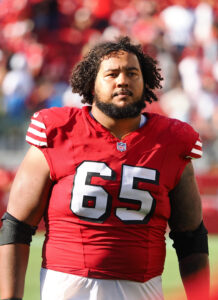
Indeed, only two notable new faces arrived as part of this year’s class. Banks was not a factor during his rookie campaign in San Francisco, but the following three seasons saw him operate as a full-time starter. The former second-rounder avoided major injury over that span, playing a key role in the 49ers’ offense and playing his way out of a second deal with the team. San Francisco had a number of other financial priorities, leaving Banks (PFR’s No. 21 free agent) as one of the best interior blockers available this spring.
As expected, Banks departed the Bay Area early in free agency. The Notre Dame product secured an AAV of $19.25MM, a figure which ranked fifth for guards at the time (Trey Smith has since replaced his franchise tag with a market-topping Chiefs extension). Expectations will certainly be high for Banks as a result; he will replace Elgton Jenkins at the left guard spot for the foreseeable future.
Set to turn 28 in September, Banks has not drawn standout evaluations from Pro Football Focus to date in his career. Pass protection in particular has been an issue, although 2024 marked his best campaign in terms of run blocking grade and overall evaluation. Still, Banks has finished no better than 33rd amongst guards so far. Banks’ free agent market would stand to disagree with PFF’s assessments, but the Packers are certainly banking on an uptick readies to debut for his second career team.
Keeping with organizational policy, Hobbs joined Banks in receiving his only fully guaranteed money in the form of a signing bonus. He can nevertheless be counted on to remain in the fold through at least 2026 based on the structure of his pact. A full-time starting gig awaits the former Raider for however long he is in place with Green Bay.
 Hobbs saw time on the perimeter while playing out his rookie contract, but the Raiders primarily deployed him in the slot. The former fifth-rounder is expected to be used in both capacities with his new team, one which enters the season with questions in the secondary. Hobbs, 26, missed a total of 17 games across his four Raiders campaigns. In addition to high-end play, availability will be a central goal over the coming years in his case as a result.
Hobbs saw time on the perimeter while playing out his rookie contract, but the Raiders primarily deployed him in the slot. The former fifth-rounder is expected to be used in both capacities with his new team, one which enters the season with questions in the secondary. Hobbs, 26, missed a total of 17 games across his four Raiders campaigns. In addition to high-end play, availability will be a central goal over the coming years in his case as a result.
A preventative knee surgery took place earlier this month, so while Hobbs could be back to full strength in time for the start of the season his Green Bay tenure has not gotten off to a worry-free start on the health front. Provided the Illinois product can stay on the field, though, continued improvement in terms of pass coverage – coming off personal bests in completion percentage and passer rating allowed in 2024 – would make him a worthwhile addition.
The Packers were among the teams which showed interest in former first-rounder Damon Arnette. After a one-year spell in the UFL, Arnette put himself back on the NFL radar and ultimately landed with the Texans. Green Bay did not take a flier in that instance, but the team did so in the case of Simmons.
The former Cardinals top-10 pick struggled in Arizona while failing to find a permanent role on defense. A trade to the Giants allowed Simmons to spend 2024 in New York; he appeared in every game while seeing sparse usage on defense and special teams. The 27-year-old will work full-time as a linebacker in Green Bay. Success in that capacity could result in a stronger market next spring.
Re-signings:
- Brandon McManus, K. Three years, $15.3MM ($5MM guaranteed)
- Isaiah McDuffie, LB. Two years, $8MM ($2.55MM guaranteed)
- John FitzPatrick, OL. One year, $1.5MM ($125K guaranteed)
- Arron Mosby, OLB. One year, $1.03MM
Prior to free agency, it became clear the Packers intended to retain McManus for 2025 and beyond. Such a stance was certainly understandable given the veteran’s showings in 11 Green Bay games last year. McManus missed only two of his 23 total field goal attempts during the regular season and playoffs. The 34-year-old was also perfect on extra points. 
McManus saw his nine-year Broncos run come to an end in 2023; that resulted in a 17-game period handling kicking duties with the Jaguars. A free agent signing with the Commanders followed, although the Super Bowl 50 winner was then named in a lawsuit alleging sexual assault during an international flight during his Jacksonville tenure. The Commanders cut McManus, but after the league’s decision not to suspend him another fresh start become available.
In the wake of the Anders Carlson selection not panning out as hoped, the Packers cycled through several options before finding stability in the form of McManus. The Temple product is now in position to serve as a (relatively) long-term Mason Crosby successor, provided he plays out at least most of his current pact. At an AAV of $5.1MM, McManus’ deal sits tied for ninth amongst kickers in annual compensation.
Over the course of his four Green Bay seasons, McDuffie has seen a year-over-year jump in playing time. The former sixth-rounder’s defensive snap share checked in at 64% in 2024 and he started every game. Coming off a career high in tackles (97), McDuffie is once again set to serve as an important contributor at the second level of Green Bay’s defense alongside Quay Walker and Edgerrin Cooper. No member of that trio is attached to a lucrative pact, and McDuffie’s modest second NFL accord could prove to be valuable if he manages to duplicate last year’s play.
Notable losses:
- Jaire Alexander, CB (released)
- Kahzir Brown, S (waived)
- Sam Brown Jr., WR (waived/injured)
- Andre Dillard, LT
- AJ Dillon, RB
- Tulu Griffin, WR (waived)
- Alex Hale, K (waived)
- Kaleb Hayes, CB (waived)
- Marquis Hayes, OL (released)
- Janson Jake, WR (waived)
- Gregory Junior, CB (waived)
- Jeremiah Martin, DL (waived/injured)
- Josh Myers, C
- Leonard Payne, DT (waived)
- Robert Rochell, CB
- Nesta Jade Silvera, DT (waived)
- T.J. Slaton, DT
- Eric Stokes, CB
- Eric Wilson, LB
- Cameron Young, DT (waived)
 As soon as the Nate Hobbs signing took place, the chances of an Alexander departure increased. The latter spent his first seven years in Green Bay, landing what was at signing a market-topping cornerback extension based on his early play. Considerable missed time increasingly became a problem in Alexander’s case, however.
As soon as the Nate Hobbs signing took place, the chances of an Alexander departure increased. The latter spent his first seven years in Green Bay, landing what was at signing a market-topping cornerback extension based on his early play. Considerable missed time increasingly became a problem in Alexander’s case, however.
Having missed double-digit games three of the past four seasons, Alexander was not a feasible candidate to continue playing out the remaining two years of his $21MM-per-year pact absent an adjustment. Trade talks took place over an extended period, but to no surprise suitors were hesitant about taking on his contract. A pay cut was offered in May; in the absence of an agreement on that front, Alexander remained a strong candidate to play elsewhere in 2025.
The two-time Pro Bowler made it clear a release would be preferred to a trade (all the while maintaining the expectation a new Packers arrangement would eventually be worked out). Green Bay’s restructure offer would have set Alexander up for free agency in 2026, but the proposal did not include any up-front guarantees for this season. In the end, the Packers decided to proceed with a release — without a post-June 1 designation. As a result, a $17MM-plus dead cap charge will be applied to 2025 before Alexander’s contract comes off the books entirely next year. 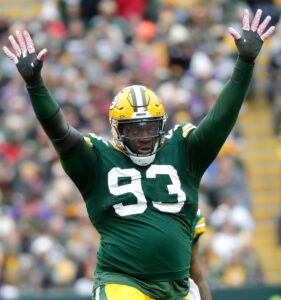
As expected, free agent interest emerged immedicably after the release took place. Turning aside more lucrative offers, Alexander chose to reunite with former Louisville teammate Lamar Jackson by taking a one-year Ravens deal. A healthy showing within Baltimore’s highly regarded secondary could result in a notable free agent market next spring. Failing that, the 28-year-old could very well struggle to move his earning power back to where it once was.
Slaton certainly outperformed expectations while playing out his rookie contract in Green Bay. The former fifth-rounder saw part-time work during his first two seasons and developed into a full-time starter after that. In 2023, Slaton handled a career-high snap share of 56% and set a new personal mark with 50 tackles.
While the 27-year-old’s playing time and output took a downturn last season, he played his way into a Bengals pact on the open market. Slaton will continue to serve as a run-stopping presence with his new team. Green Bay ranked seventh against the run in 2024, and remaining strong in that regard without their recent nose tackle starter will be key.
 Myers represents the most notable loss on offense. A 56-game starter with Green Bay, his preference was to remain in place on his second contract. Instead, a departure took place by means of a Jets deal which may not result in the starting gig. Myers, 27, ranked between 26th and 38th in terms of center PFF grades during his Packers tenure. The team will aim for improvement with its new arrangement up front.
Myers represents the most notable loss on offense. A 56-game starter with Green Bay, his preference was to remain in place on his second contract. Instead, a departure took place by means of a Jets deal which may not result in the starting gig. Myers, 27, ranked between 26th and 38th in terms of center PFF grades during his Packers tenure. The team will aim for improvement with its new arrangement up front.
Like Alexander, Stokes struggled to remain healthy and thus to meet expectations in Green Bay. The former first-rounder managed to play 17 games last year, but he did so while logging the lowest snap share (54%) of his career. A starting spot should await Stokes with the Raiders, but his role could change in the event of a late-summer cornerback addition being made in Vegas.
Over the course of his three seasons in Green Bay, Wilson took on an increased workload both on defense and special teams. His 12 starts and 558 defensive snaps were the second most of his career, so the 30-year-old’s absence could be felt in 2025. The Packers will face Wilson at least twice this season since he returned to the Vikings on the open market.
Extensions and restructures:
- Extended RT Zach Tom on four-year, $88MM deal ($30.2MM guaranteed)
In time for training camp, a major (but expected) raise came to fruition in Tom’s case. Following a rookie campaign which saw Tom handle part-time usage at multiple positions, the 26-year-old settled into an effective role as Green Bay’s right tackle. Tom ranked 15th amongst qualifying tackles in PFF grade for 2024, and he improved to sixth last season. With three of the blockers above him in that regard playing on the blind side, it comes as no surprise the Packers authorized one of the most lucrative right tackle pacts in this case. 
Tom’s $22MM average annual value ranks third in the NFL at the RT spot. That is also true with respect to all current Packers contracts (behind only quarterback Jordan Love and edge rusher Rashan Gary). As the highest-paid member of Green Bay’s offensive line, expectations will be elevated in Tom’s case; he will certainly have plenty of time to meet them since he is under contract through 2029 as a result of the new accord.
The starting left tackle position is up for grabs as the Packers look for their ideal five-man combination up front. That could see Rasheed Walker maintain his spot on the blind side, although 2024 first-rounder Jordan Morgan is an candidate to unseat him. In any case, Tom will be counted on as an anchor up front now and for years to come. Continued performances as one of the league’s top tackles – especially given his age – would prove the Wake Forest product to be a worthwhile commitment on the team’s part. Given Tom’s track record to date, this investment should be viewed as a safe one.
Draft:
- Round 1, No. 23: Matthew Golden (WR, Texas) (signed)
- Round 2, No. 54: Anthony Belton, T (NC State) (signed)
- Round 3, No. 87: Savion Williams (WR, TCU) (signed)
- Round 4, No. 124: Barryn Sorrell (DE, Texas) (signed)
- Round 5, No. 159: Collin Oliver (DE, Oklahoma State) (signed)
- Round 6, No. 198: Warren Brinson (DT, Georgia) (signed)
- Round 7, No. 237 (from Steelers): Micah Robinson (CB, Tulane) (signed)
- Round 7, No. 250*: John Williams (G, Cincinnati) (signed)
 Prior to the Golden selection, 2002 marked the Packers’ most recent first-round investment in a receiver. Several Day 2 picks have proven fruitful, but relying on them almost exclusively throughout the Aaron Rodgers era increasingly became a talking point regarding organizational practice. As hosts of the draft this April, Green Bay elected to take a different route.
Prior to the Golden selection, 2002 marked the Packers’ most recent first-round investment in a receiver. Several Day 2 picks have proven fruitful, but relying on them almost exclusively throughout the Aaron Rodgers era increasingly became a talking point regarding organizational practice. As hosts of the draft this April, Green Bay elected to take a different route.
Golden delivered a strong one-and-done campaign with the Longhorns. The former Houston product transferred within the state for 2024 and posted a 58-987-9 statline. Down the stretch in particular, he emerged as a major contributor and showcased his ability as a deep threat. At the Combine, a 4.29 40-yard dash time further cemented Golden’s status as one of the top receiver prospects in this year’s class.
The Packers showed interest in one of the other premier WR options, Tetairoa McMillan. A move up the board proved to be unfeasible, though, with the Panthers staying pat at No. 8. Trade calls came in for the 23rd pick from the Eagles, but Green Bay also elected to remain in place. As a result, Golden is positioned to operate as a key figure in the team’s oft-discussed (based on an unclear pecking order) receiving corps.
With Golden and Williams – who enjoyed a 60-catch campaign in 2024 and, at 6-foot-5, will bring a notable size element to the Packers’ offense – being added, further questions were raised about how things would shake out at the position. Indeed, the rookie wideouts will spend their initial NFL campaigns competing for targets with Christian Watson (when healthy), Jayden Reed, Romeo Doubs, Dontayvion Wicks and Malik Heath, with Mecole Hardman also a depth option if his role expands beyond return duties. 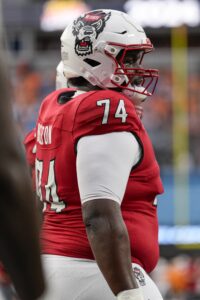
Indeed, Reed expressed (through his agent) concerns about his role moving forward. Two years remain on Reed’s rookie contract, and the same is true of Wicks. Watson and Doubs are pending 2026 free agents, though, so expanded workloads for Golden in particular and potentially Williams next year could be in store. How the wideout pecking order gets sorted out will be interesting to monitor on an offense filled with returnees at the skill positions.
An older prospect due to his two years at Georgia Military College, Belton finished his college career with three straight seasons as a starting left tackle. The 336-pounder could offer depth on the blind side, but a more realistic projection would see him line up at guard in the NFL. In either case, a path to an immediate starting role does not appear to exist.
Aaron Banks and fourth-year Packer Sean Rhyan are positioned to handle first-team duties at each guard spot in 2025. The latter is entering the final year of his rookie pact, meaning a free agent departure could be on tap next spring. If that were to take place, Jordan Morgan would become a candidate for the starting right guard gig. The same would also, presumably, be true in Belton’s case Failing that, a multiyear run as a backup option could be in store.
Other:
- Led unsuccessful effort to ban Tush Push
- HC Matt LaFleur, GM Brian Gutekunst will not receive early extensions
- Ed Policy succeeded Mark Murphy as president/CEO
- Extended ST coordinator Rich Bisaccia
- Nathaniel Hackett returned to coaching staff
- Hired DeMarcus Covington as defensive line coach, promoted Sean Mannion to QBs coach
- LBs coach Anthony Campanile took Jaguars’ DC position; team promoted Sean Duggan as replacement
- Exercised DT Devonte Wyatt’s $12.94MM fifth-year option, declined LB Quay Walker’s $14.75MM option
- Elgton Jenkins transitioned from G to C; Bo Melton transitioned from WR to CB
- WR Christian Watson likely to begin season on reserve/PUP list
- Discussed reunion with WR Davante Adams; team showed trade interest in WR George Pickens, free agent interest in WR Cooper Kupp
- Claimed RB Israel Abanikanda off waivers from 49ers
- Claimed WR Kawaan Baker off waivers from Raiders
- Signed 10 UDFAs
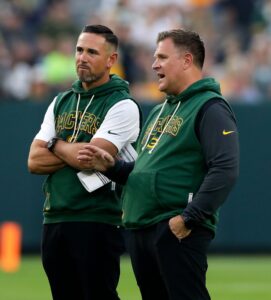 In March, the matter of a Tush Push ban proved to be divisive amongst NFL decision-makers. A vote on the matter was postponed before the language of Green Bay’s proposal was altered. The team’s attempt to return rules on pushing ball carriers to pre-2005 standards received support, with 22 teams voting in favor in May.
In March, the matter of a Tush Push ban proved to be divisive amongst NFL decision-makers. A vote on the matter was postponed before the language of Green Bay’s proposal was altered. The team’s attempt to return rules on pushing ball carriers to pre-2005 standards received support, with 22 teams voting in favor in May.
That fell just short of the required three-fourths majority for rule changes, however. Last-minute efforts on the part of the Eagles resulted in sufficient support for keeping the play alive in 2025, at least. Further attempts at a ban in the future would come as no surprise, and the Packers may again find themselves playing a leading role in that respect.
The planned succession from Murphy to Ed Policy — son of former 49ers GM Carmen Policy — took place as expected, setting up stability on the business side of the franchise for years to come. Continuity will also be witnessed on the sidelines and in the front office for 2025. The matter of new commitments for LaFleur and/or Gutekunst will become a talking point over the course of the campaign given the decision to avoid extensions this offseason.
Policy noted his disdain for head coaches or general managers operating under lame-duck status. As a result, new contracts in both cases should be expected, barring a major disappointment over the coming months. LaFleur ranks seventh in terms of the league’s longest-tenured head coaches. Gutekunst, meanwhile sits (for all intents and purposes) in 11th in that respect amongst general managers. The Packers sport a .670 regular season winning percentage since LaFleur’s first season (2019), and they have reached the postseason five times in seven years under Gutekunst. 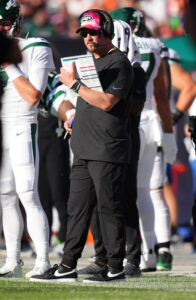
That pair will have a familiar face back in the fold with Hackett returning to Green Bay. The 45-year-old’s head coaching gig with the Broncos proved to be disastrous, and his reunion with Aaron Rodgers as the Jets’ offensive coordinator did not fare much better. Hackett’s background is on the offensive side of the ball, but his return will include duties as an analyst working with the Packers’ defense. That unit enjoyed a strong first year under Jeff Hafley in 2024, and maintaining its success could allow for Hackett to begin rebuilding his coaching stock.
Green Bay’s defensive staff will have another ex-coordinator in the form of Covington. After seven years on the Patriots’ staff, he took on defensive coordinator responsibilities under Jerod Mayo in 2024. With Mike Vrabel coming in following the one-and-done Mayo tenure, though, Covington was among the staffers who found themselves on the move during the coaching cycle. The ninth-year NFL staffer interviewed for Cincinnati’s DC position before taking his new role in Green Bay. The team’s defensive front will be a unit to watch closely given its expectations, and Covington, 36, figures to play a key role in its performance.
 The statuses of both Wyatt and Walker became a talking point dating back to before the start of the 2024 season. Both former Georgia teammates remained regulars last season, although Wyatt saw his snap share drop compared to the previous year (down from 50% to 41%). A statistical fall-off did not ensue, however.
The statuses of both Wyatt and Walker became a talking point dating back to before the start of the 2024 season. Both former Georgia teammates remained regulars last season, although Wyatt saw his snap share drop compared to the previous year (down from 50% to 41%). A statistical fall-off did not ensue, however.
Wyatt managed five sacks and 12 quarterback pressures in 2024, further establishing his presence as a disruptive presence along the interior. The 27-year-old still faces questions about his run defense, though, and improvement in that regard will be needed as he takes on a full-time starting gig. T.J Slaton’s departure will allow Wyatt to assume a larger role in preparation for a notable raise in 2026. A step forward would make an extension decision easier for Green Bay, a team which has Kenny Clark on the books for another three seasons.
It came as little surprise when Walker’s option was declined. The merging of inside and outside linebackers for the purpose of option valuations has led to a growing trend of teams opting for early free agency in cases such as his. Still, Gutekunst made it clear in April he intended to keep both Wyatt and Walker in the fold beyond 2025. The latter has already been the subject of extension talks, so a long-term pact could be in store down the road.
Walker, 25, has filled the statsheet so far with 341 tackles and 6.5 sacks to his name. He has yet to miss considerable time through injury, and a regular partnership alongside highly touted 2024 second-rounder Edgerrin Cooper could prove to be effective. Walker will not collect a top-eight linebacker salary in 2026 (as he would have in the event of his option being picked up), but a considerable increase compared to his scheduled $4.4MM this year will be required if a long-term arrangement is to be worked out. 
Jenkins was initially hesitant about switching positions, and he sought a contract adjustment reflecting his new role. The two-time Pro Bowler is aware by now, however, that no such development will take place. The top of the guard market comfortably outpaces that of centers, a financial reality Jenkins and his camp is well aware of. The last holdover from the Rodgers MVP years, Jenkins has seen his four-year, $68MM contract drop from first among Packer O-linemen to third. No guaranteed money remains on the 29-year-old blocker’s deal for 2026; any extension worked out next spring will no doubt be influenced heavily by the differing financial landscape up front.
Given the young (and highly inexpensive nature) of Green Bay’s receiver room, a move like bringing back Adams or acquiring a less familiar high-profile wideout certainly would have altered the roster balance of that position. An Adams reunion in particular could have elevated the team’s expectations through the air. Instead, he returned to the West Coast on a Rams deal. Pickens and Kupp will reside in the NFC as well in 2025 as the Packers aim for further internal growth at the WR spot.
Melton will not play a role in that effort, with his cornerback experiment proceeding on a full-time basis. Retained on an ERFA tender this offseason, the 26-year-old’s earning power for next year (with Green Bay or another team, if he winds up being non-tendered) will be determined by the success of his play on defense.
Top 10 cap charges for 2025:
- Jordan Love, QB: $29.69MM
- Rashan Gary, OLB: $25.77MM
- Kenny Clark, DT: $20.37MM
- Xavier McKinney, S: 17.85MM
- Elgton Jenkins, C: $17.6MM
- Josh Jacobs, RB: $11.33MM
- Aaron Banks, LG: $9.03MM
- Zach Tom, RT: $7.37MM
- Keisean Nixon, CB: $6.84MM
- Nate Hobbs, CB: $5.99MM
Continuity amongst Green Bay’s core should be expected in the intermediate future with each of these 10 players listed on the books for 2026 as well. Among those projected to see a major spike in cap charge from one year to the next are Clark and Banks, so they will be candidates for contract adjustments next spring. The Packers will carry over $35MM in dead money charges in 2025.
Not unlike the Texans in the AFC, the Packers enter the coming season with a track record of being able to reach the postseason but questions about their ability — in the Love years, at least — to sustain a run to the Super Bowl. Love’s 2024 inconsistency fueled criticism of Green Bay’s $55MM-per-year commitment to him, and the third-year starter’s performance will of course receive considerable scrutiny throughout the season as he looks to truly establish himself among the game’s elite under center.
The division rival Lions and Vikings return strong rosters, and a new Bears staff is the source of optimism for development in Chicago. Meanwhile, 2024 contenders in the conference should once again present challenges this year. Whether or not Green Bay’s (largely intact) core can take a step forward will be one of the NFC’s most important storylines in 2025.

Quiet offseason?
They moved on from their #1 CB, drafted a WR in the 1st (effectively redoing WR room), signed (overpaid) an OG, moved Jenkins to C.
Sounds like the opposite of quiet.
The drama meter in Green Bay was never this low when Rodgers was there so that’s a big plus. Even with the youngest roster in the league this is a competitive group. Regardless of what people think of Gutekunst he’s doing a good job.
Drama is the same thing as roster changes.
And “youngest roster” is a cop out. Packers always have one of the youngest rosters — goes hand-in-hand with the “draft and develop” strategy,
*isn‘t the same thing.
Seven teams changed head coaches this offseason. Another one lost both coordinators. Another six lost or fired one. Ten teams changed quarterbacks.
The Packers had some important changes, but they still had a relatively quiet offseason, yes.
“Myers represents the most notable loss on offense.”
Myers wasn’t a loss at all, he was awful. good riddance
As a Packer fan who likes MLF and Gute and who thinks very highly of Loves ability, I think this is the year we start to see how great the team can become post Rodgers. It was last time to send him off. It is time now to seee the fruit of that gutsy call.
Solid 12 win team
pass me some of that
How’s that lookin now bub?
Ahem. You were saying?
pick 6 called back, a dropped int, over throw wide open guys. maybe a playoff team, certainly won’t beat an elite team
😂😂 keep coping bruh.
Fourth straight game under 200 yards passing. Elite stuff. stay in school kid
He was nails in the first half and didn’t need to do anything else second half.
Keep coping, hater. Us Packers fans drink your tears. 🤡
Love is basically Kirk Cousins 2.0. He’ll never lead them to the promised land and he’ll be lucky to win 3-4 BIG games. Cousins 2.0
Seriously? This is a dumb take. Love was excellent yesterday in slaughtering the Lions btw.
Yes. I’m petty. Yes. Receipts were taken. 🙂